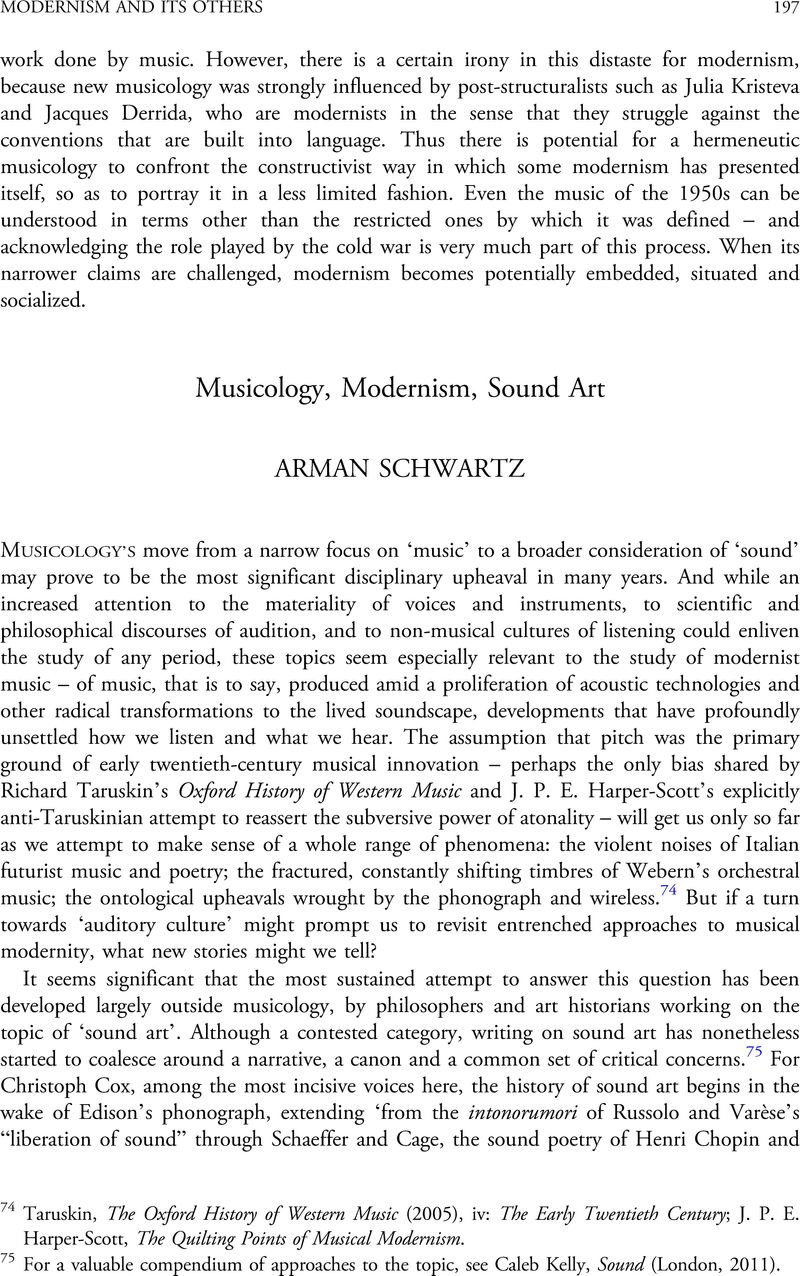No CrossRef data available.
Article contents
Musicology, Modernism, Sound Art
Published online by Cambridge University Press: 01 January 2020
Abstract

- Type
- Round Table: Modernism and its Others
- Information
- Copyright
- Copyright © 2014 The Royal Musical Association
References
74 Taruskin, The Oxford History of Western Music (2005), iv: The Early Twentieth Century; J. P. E. Harper-Scott, The Quilting Points of Musical Modernism.
75 For a valuable compendium of approaches to the topic, see Caleb Kelly, Sound (London, 2011).
76 Christoph Cox, ‘Sound Art and the Sonic Unconscious’, Organized Sound, 14 (2009), 19–26 (p. 25).
77 Christoph Cox, ‘Sound Art and the Sonic Unconscious’, Organized Sound, 14 (2009), 24.
78 Christoph Cox, untitled contribution to ‘Abstraction, 1910–1925: Eight Statements’, October, 143 (2013), 28–31 (p. 30).
79 Key texts in this discussion include, in addition to the essays by Cox cited above, Douglas Kahn, Noise Water Meat: A History of Sound in the Arts (Cambridge, MA, 2001); Seth Kim-Cohen, In the Blink of an Ear: Toward a Non-Cochlear Sonic Art (New York, 2009); and Salomé Voegelin, Listening to Noise and Silence: Towards a Philosophy of Sound Art (New York, 2010).
80 See Brian Kane, ‘Musicophobia, or Sound Art and the Demands of Art Theory’, <nonsite.org>, 8 (2012/13), 1–18 (accessed 27 February 2013).
81 See Brian Kane, ‘Musicophobia, or Sound Art and the Demands of Art Theory’, <nonsite.org>, 8 (2012/13), 15.
82 See Thomas Y. Levin, ‘“Tones Out of Nowhere”: Rudolph Pfenninger and the Archeology of Synthetic Sound’, Grey Room, 12 (2003), 32–79 (p. 60).
83 For an eye-opening attempt, however ‘popular’, to think about Stokowski in the context of sound technology, see Greg Milner, Perfecting Sound Forever: An Aural History of Recorded Music (New York, 2009), 50–76. For Gould's own thoughts on his predecessor, see his ‘Stokowski in Six Scenes’, The Glenn Gould Reader, ed. Tim Page (New York, 1990), 258–82.
84 I refer, of course, to the use of pre-recorded birdsong in the‘Pini del Gianicolo’ movement of Pini di Roma (1924). For attempts to contextualize Respighi's innovation as, variously, grammophonmusik, media link and late Romantic literalism with suspect political undertones, see Mark Katz, Capturing Sound: How Technology has Changed Music (Berkeley, CA, 2010), 118; Friedrich Kittler, Gramophone, Film, Typewriter, trans. Geoffrey Winthrop-Young and Michael Wutz (Stanford, CA, 1999), 98; and Taruskin, The Oxford History of Western Music (2005), iv, 750.


